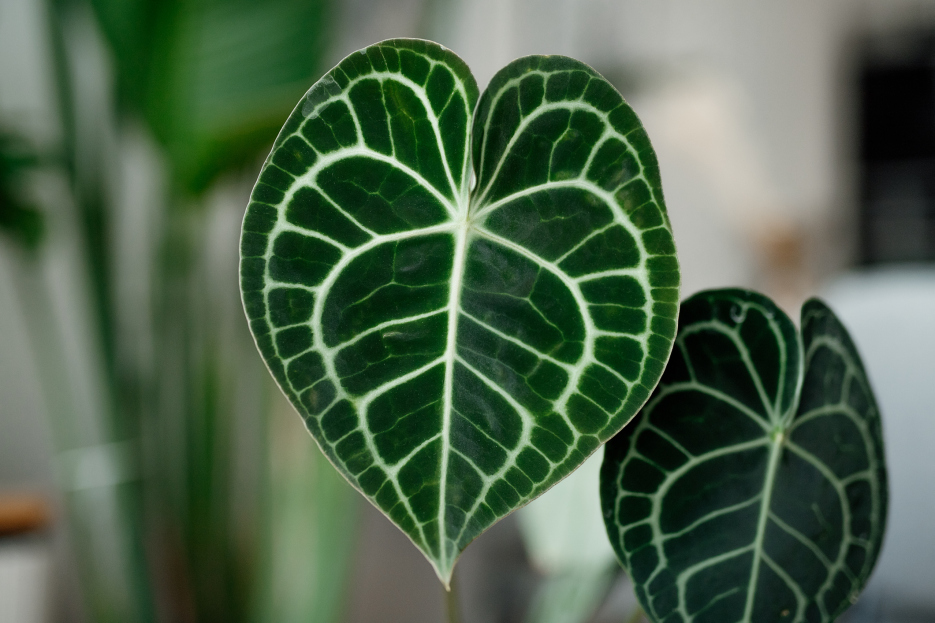
Anthurium 'Clarinervium' is a truly remarkable houseplant known for its stunning heart-shaped, velvety leaves adorned with bold white veining. Native to the rainforests of Mexico, this variety of Anthurium has gained popularity among plant enthusiasts for its unique beauty and relatively low-maintenance care requirements. Whether you're a seasoned plant lover or new to indoor gardening, this guide will provide all the information you need to keep your Anthurium 'Clarinervium' healthy and thriving.
Anthurium 'Clarinervium' thrives in bright, indirect light. Much like its rainforest origins, this plant prefers filtered sunlight, which helps highlight its beautiful leaf veins without causing the leaves to scorch. Direct sunlight can lead to sunburn, causing the leaves to turn yellow or brown.
If you're growing your Anthurium indoors, a bright spot near an east- or north-facing window is ideal. If the plant begins to show signs of leggy growth or fading colors, it might be an indication that it needs more light. However, it’s crucial to avoid placing the plant in direct sunlight for long periods to protect the leaves.
Watering Anthurium 'Clarinervium' properly is key to keeping it healthy. This plant enjoys consistently moist soil, but it’s important not to overwater it. The soil should be allowed to dry out slightly between waterings, and it’s best to water the plant when the top 1–2 inches of soil feel dry to the touch.
During the growing season (spring and summer), you may need to water your Anthurium every 1-2 weeks, depending on the humidity and temperature in your home. In the cooler months (fall and winter), reduce watering slightly since the plant's growth slows down.
Always ensure that the pot has drainage holes to allow excess water to escape, as waterlogged roots can cause root rot. If you’re unsure when to water, it’s better to wait a little longer than to overwater.
Anthurium 'Clarinervium' is a tropical plant that enjoys warmth and humidity. The ideal temperature for this plant is between 65°F and 80°F (18°C to 27°C). Avoid placing it in areas that experience drafts or temperature fluctuations, such as near air conditioners, heaters, or open windows.
Humidity is especially important for this plant. As a rainforest native, it thrives in environments with humidity levels of 60% or higher. If the air in your home is dry, especially during the winter months, consider using a humidifier or placing the plant on a humidity tray with water and pebbles. Misting the leaves regularly can also help increase humidity, though it’s best to avoid over-saturating them.
Anthurium 'Clarinervium' benefits from regular feeding during its growing season (spring and summer). Use a balanced, water-soluble fertilizer diluted to about one-quarter to half the recommended strength. Fertilize once every 4-6 weeks to encourage healthy growth and vibrant foliage.
Avoid fertilizing during the winter months when the plant is in its dormant phase. Over-fertilizing can lead to salt buildup in the soil, which can damage the roots and affect the plant’s overall health. Always water the plant thoroughly before applying any fertilizer to prevent root burn.
Anthurium 'Clarinervium' can be propagated through stem cuttings, though it requires some patience. Follow these steps to propagate your plant successfully:
Propagation can be slow, but with patience and proper care, you’ll eventually have a new plant to enjoy.
Anthurium 'Clarinervium' is a relatively low-maintenance plant but may require some occasional pruning to maintain its shape and health. Remove any dead or damaged leaves by cutting them back at the base of the stem. Regularly dust the leaves with a soft cloth to remove any dirt or debris, which can clog the plant’s pores and reduce its ability to photosynthesize.
If your plant becomes too leggy or overgrown, you can trim back the stems to encourage new growth. This will help the plant maintain a more compact and bushy shape. Always use clean, sharp scissors or pruning shears to avoid transferring any potential diseases.
Anthurium 'Clarinervium' is toxic to pets, including cats and dogs. Like other members of the Anthurium family, it contains calcium oxalate crystals, which can cause irritation to the mouth, throat, and digestive system if ingested. Symptoms of poisoning in pets include drooling, vomiting, and difficulty swallowing.
To keep your pets safe, place the plant out of reach and be cautious if you have curious animals in your home. If your pet ingests any part of the plant, contact your veterinarian immediately for guidance.
Q: Why are the leaves of my Anthurium 'Clarinervium' turning yellow?
A: Yellowing leaves can be a sign of overwatering, underwatering, or insufficient light. Ensure that the soil is well-draining, and the plant is receiving the right amount of indirect light. Also, check the plant for any pests that might be affecting its health.
Q: How can I encourage more growth on my Anthurium 'Clarinervium'?
A: To encourage more growth, ensure your plant is getting plenty of indirect light, warmth, and humidity. If it’s growing leggy, try trimming back the stems to encourage bushier growth. Fertilize regularly during the growing season to promote healthy leaf development.
Q: How often should I repot my Anthurium 'Clarinervium'?
A: Repot your Anthurium every 1-2 years, or when it becomes root-bound. Choose a pot that is 1-2 inches larger than the current one, and use a well-draining potting mix. Repotting during the spring or summer, when the plant is actively growing, will help it adjust more easily.
Q: Can I grow Anthurium 'Clarinervium' outdoors?
A: Anthurium 'Clarinervium' is best suited for indoor growing in temperate climates. If you live in USDA hardiness zones 10-11, you can grow it outdoors in a shaded area that mimics its native rainforest environment. Be sure to protect it from direct sunlight and cold temperatures.
By following these care tips, your Anthurium 'Clarinervium' will flourish and provide you with beautiful, glossy leaves that are sure to be a conversation starter. With a little attention to detail, you’ll enjoy the elegance and grace of this stunning plant for years to come.